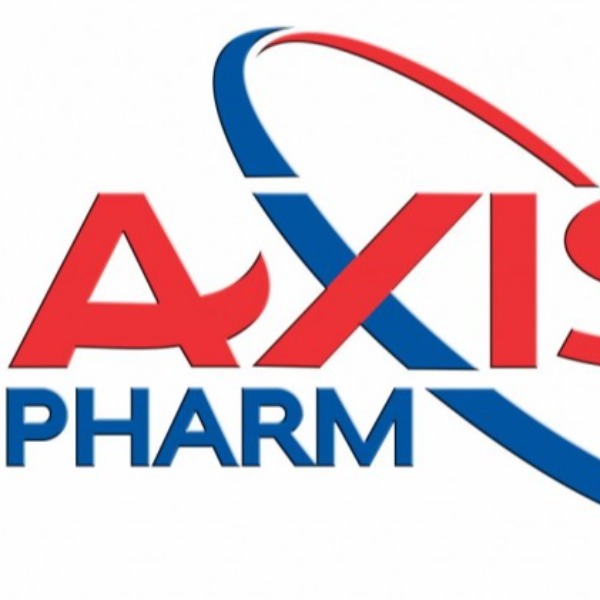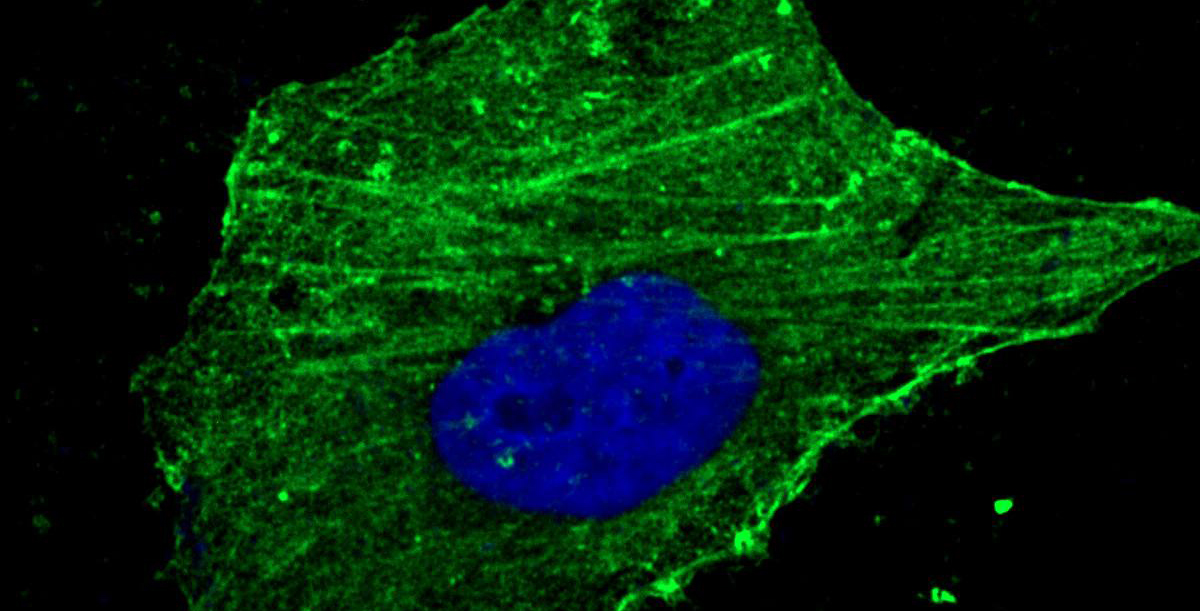Introduction of APDye Fluors 647
APDye Fluor 647 is structurally similar to Alexa Fluor 647(AF647), and spectrally is almost identical to Cy5 Dye, Alexa Fluor 647, CF 647 Dye, or any other Cyanine5 based fluorescent dyes. APDye Fluor 647 is a bright green-fluorescent dye optimal for use with the 633, 650 nm Argon laser. The dye is water soluble and pH-insensitive from pH 4 to pH 10. The dye has 4 sulfonate groups make it high water soluble and less aggregation in the aqueous solution. APDye Fluor 647 is used for protein and antibody labeling, or nucleic acid applications with high labeling density.
Probes with high fluorescence quantum yield and high photostability allow detection of low-abundance biological structures with great sensitivity. APDye Fluor 647 dye molecules can be attached to proteins at high molar ratios without significant self-quenching, leading to brighter conjugates and more sensitive detection.
We offer APDye Fluor 647 dye conjugated to a variety of antibodies, peptides, proteins, tracers, and amplification substrates optimized for cellular labeling and detection. In addition, reactive dye forms and protein labeling kits are available to allow you to generate your own antibody conjugates or probes.
APDye Fluor 647 Hydrazide
APDye™ Fluor 647 Hydrazide (Alexa Fluor® 647 Hydrazide replacement) is a bright, far-red-fluorescent dye that often used for labeling aldehydes or ketones in polysaccharides or glycoproteins. APDye™ Fluor 488 Hydrazide is useful as low molecular weight, membrane-impermeant, aldehyde-fixable cell tracers, exhibiting brighter fluorescence and greater photostability than cell tracers derived from other spectrally similar fluorophores.
APDye™ Fluor 647 (Alexa Fluor ® 647 analog) is a water-soluble, bright, far-red-fluorescent dye with excitation ideally suited for the 633 nm or 647 nm laser lines. A significant advantage to using long wavelength dyes such as Cy5 or APDye™ Fluor 647 dye over other fluorophores is the low autofluorescence of biological specimens in this region of the spectrum.
APDye™ Fluor 647 is structurally similar to Alexa Fluor® 647, and spectrally is almost identical to Cy5 Dye, Alexa Fluor® 647, CF® 647 Dye, or any other Cyanine5 based fluorescent dyes.
APDye Fluor 647 Alkyne
APDye 647 Alkyne (Alexa Fluor 647 Alkyne analog) is a water-soluble, bright, far-red fluorescent dye with excitation ideally suited for the 633 nm or 647 nm laser lines. A significant advantage to using long wavelength dyes such as Cy5 or APDye™ Fluor 647 dye over other fluorophores is the low autofluorescence of biological specimens in this region of the spectrum.
APDye™ Fluor 647 Alkyne is a bright, far-red fluorescent, pH insensitive alkyne-activated probe routinely used for imaging of azide-containing biomolecules. APDye™ Fluor 647 Alkyne reacts with azides via a copper-catalyzed click reaction (CuAAC) to form a stable triazole linker. A probe for copper-less detection (APDye™ Fluor 647 DBCO) is also available for application where the presence of copper is not acceptable.
APDye™ Fluor 647 is structurally similar to Alexa Fluor® 647, and spectrally is almost identical to Cy5 Dye, Alexa Fluor® 647, CF® 647 Dye, or any other Cyanine5 based fluorescent dyes.
APDye Fluor 647 Azide
APDye™ Fluor 647 Azide (Alexa Fluor 647 Azide analog) is a water-soluble, pH-insensitive from pH 4 to pH 10 bright, far-red fluorescent probe with excitation ideally suited for the 633 nm or 647 nm laser lines. A significant advantage to using long wavelength dyes such as Cy5 or APDye™ Fluor 647 dye over other fluorophores is the low autofluorescence of biological specimens in this region of the spectrum.
APDye™ Fluor 647 Azide can be reacted with terminal alkynes via a copper-catalyzed click reaction (CuAAC). It also reacts with strained cyclooctyne via a copper-free “click chemistry” reaction to form a stable triazole and does not require Cu-catalyst or elevated temperatures. The brightness and photostability of this dye are best suited to direct imaging of low-abundance targets.
For the detection of low abundance targets or where significant increase in signal intensity is desired please consider using next generation azides probes containing an internal copper-chelating motif.
APDye™ Fluor 647 is structurally similar to Alexa Fluor® 647, and spectrally is almost identical to Cy5 Dye, Alexa Fluor® 647, CF® 647 Dye, or any other Cyanine5 based fluorescent dyes.
APDye Fluor 647 NHS Ester
APDye Fluor 647 NHS Ester (Alexa Fluor ® 647 analog) is a water-soluble, bright, far-red-fluorescent dye with excitation ideally suited for the 633 nm or 647 nm laser lines. A significant advantage to using long wavelength dyes such as Cy5 or APDye™ Fluor 647 dye over other fluorophores is the low autofluorescence of biological specimens in this region of the spectrum.
The NHS ester (or succinimidyl ester) is the most popular amine reactive group for labeling with the primary amines of proteins (Lys), amine-modified oligonucleotides, and other amine-containing molecules. Proteins can be labeled with APDye™ Fluor 647 NHS Ester at high molar ratios without significant self-quenching, leading to brighter conjugates and more sensitive detection. APDye™ Fluor 647 conjugates are often a probe of choice for detection of low abundance targets.
APDye™ Fluor 647 is structurally similar to Alexa Fluor® 647, and spectrally is almost identical to Cy5 Dye, Alexa Fluor® 647, CF® 647 Dye, or any other Cyanine5 based fluorescent dyes.
APDye Fluor 647 Maleimide
APDye™ Fluor 647 Maleimide is a water-soluble, far-red-fluorescent dye that is spectrally similar to other 650 dyes that are used for flow cytometry, microscopy and other applications. APDye™ Fluor 647 conjugates ideally suited for the 633 nm or 647 nm laser lines. A significant advantage to using long wavelength dyes such as Cy5 or APDye™ Fluor 647 over other fluorophores is the low autofluorescence of biological specimens in this region of the spectrum.
Maleimide is the most popular sulfhydryl-reactive reactive group for conjugating the dye to a thiol group on a protein, oligonucleotide thiophosphate, or low molecular weight ligand. The maleimide group specifically and efficiently reacts with reduced thiols (sulfhydryl groups, –SH) at pH 6.5 to 7.5 to form stable thioether bond. The resulting conjugates exhibit brighter fluorescence and greater photostability than the conjugates of many other spectrally similar fluorophores.
APDye™ Fluor 647 is structurally similar to Alexa Fluor® 647, and spectrally is almost identical to Cy5 Dye, Alexa Fluor® 647, CF® 647 Dye, or any other Cyanine5 based fluorescent dyes.
APDye Fluor 647 TFP Ester
APDye™ Fluor 647 TFP Ester (Alexa Fluor ® 647 analog) is a water-soluble, bright, far-red fluorescent dye with excitation ideally suited for the 633 nm or 647 nm laser lines. A significant advantage to using long wavelength dyes such as Cy5 or APDye™ Fluor 647 dye over other fluorophores is the low autofluorescence of biological specimens in this region of the spectrum.
TFP (tetrafluorophenyl) ester is an amine-reactive activated ester that reacts with primary amines of biomolecules in the same way as the succinimidyl ester (SE or NHS-ester) to form a stable amide bond. The major advantage of TFP esters over the succinimidyl ester is much improved resistance to spontaneous hydrolysis during conjugation reactions resulting in more efficiency and better reproducible labeling of biopolymers. TFP esters are stable for several hours at the basic pH typically used for reactions–far outlasting succinimidyl esters.
APDye™ Fluor 647 is structurally similar to Alexa Fluor® 647, and spectrally is almost identical to Cy5 Dye, Alexa Fluor® 647, CF® 647 Dye, or any other Cyanine5 based fluorescent dyes.
APDye Fluor 647 Picolyl Azide
APDye Fluor 647 Picolyl Azide (Alexa Fluor 647 Picolyl Azide analog) is an advanced fluorescent probe that incorporates a copper-chelating motif to raise the effective concentration of Cu(I) at the reaction site. The rate of CuAAC reaction depends on concentrations of all reagents, including copper, thus the raise of the effective copper concentration at the reaction site dramatically increase the rate of CuAAC reaction without the need to increase concentration of azide reagent and copper.
In addition, the use of picolyl azide instead of conventional azide allows for at least a tenfold reduction in the concentration of the copper catalyst without sacrificing the efficiency of labeling.
In summary, the introduction of a picolyl moiety into an azide probe leads to a substantial increase in the sensitivity of alkyne detection. This will be of special value for the detection of low abundance targets or where significant increase in signal intensity is desired.
APDye™ Fluor 647 is structurally similar to Alexa Fluor® 647, and spectrally is almost identical to Cy5 Dye, Alexa Fluor® 647, CF® 647 Dye, or any other Cyanine5 based fluorescent dyes.
APDye Fluor 647 Azide Plus
APDye Fluor 647 Azide Plus reagents is the most recent step in improving CuAAC reaction in complex media developed by scientists at Click Chemistry Tools. APDye Fluor 647 Azide Plus reagents contain a complete copper-chelating system in their structure, allowing for the formation of strong, active copper complexes that act simultaneously as both reactant and catalyst in the CuAAC reaction. This azide-copper complex reacts almost instantaneously with alkynes under diluted conditions. This unprecedented reactivity in the CuAAC reaction is of special value for the detection of low abundance targets, improving biocompatibility, and is also valuable for any other application where greatly improved S/N ratio is highly desired.
APDye Fluor 647 DBCO
APDye Fluor 647 DBCO is a water-soluble, pH-insensitive from pH 4 to pH 10 bright, far-red fluorescent probe with excitation ideally suited for the 633 nm or 647 nm laser lines. A significant advantage to using long wavelength dyes such as Cy5 or APDye™ Fluor 647 dye over other fluorophores is the low autofluorescence of biological specimens in this region of the spectrum.
APDye™ Fluor 647 DBCO is a bright, far-red fluorescent, probe routinely used for imaging of azide-containing biomolecules without the need for copper catalyst. APDye™ Fluor 647 DBCO reacts with azides via a copper-free “click chemistry” reaction to form a stable triazole and does not require Cu-catalyst or elevated temperatures. In application where the presence of copper is a concern APDye™ Fluor 647 DBCO is an ideal alternative to copper requiring fluorescent alkynes.
APDye™ Fluor 647 is structurally similar to Alexa Fluor® 647, and spectrally is almost identical to Cy5 Dye, Alexa Fluor® 647, CF® 647 Dye, or any other Cyanine5 based fluorescent dyes.
- Like (2)
- Reply
-
Share
About Us · User Accounts and Benefits · Privacy Policy · Management Center · FAQs
© 2026 MolecularCloud





